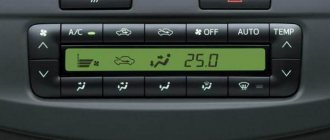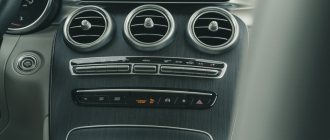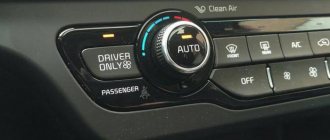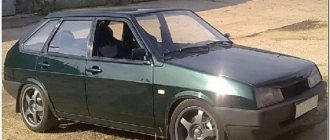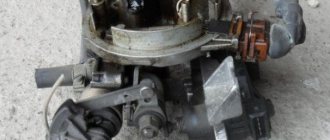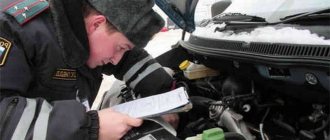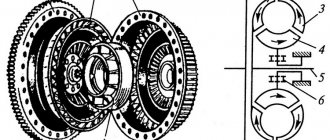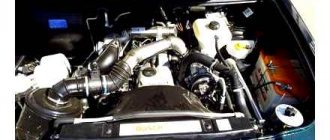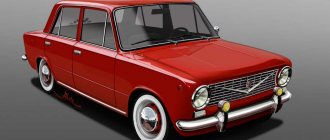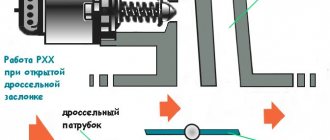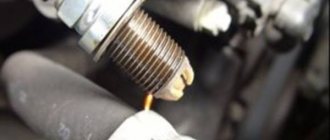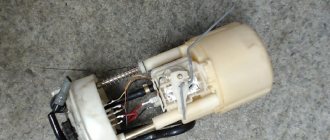Climate control Volkswagen Polo
There was a time when not many cars drove with their windows closed. And, as a rule, their owners were wealthy people. Only they could afford comfort during the hottest time of the year. The current time dictates its own rules. And today, almost every car has built-in air conditioning and climate control. The new Volkswagen polo sedan cars are equipped with a climate control function, which has fully justified itself in the first years of operation. Using it is a pleasure.
Nuances of replacing air conditioning with climate control
Only the most stubborn and environmentally obsessed citizens consider total automation to be evil. This, however, does not prevent them from traveling by car, especially over medium and long distances. For the majority of the population, including citizens of our country, a car has long been an indispensable means of transportation.
Automakers, in turn, are also trying to improve the safety, environmental friendliness and reliability of their products, not forgetting about the comfort for the driver and passengers. The latest generation models are literally crammed with electronic systems that make it easier to stay in the vehicle. One of such systems is climate control, which can control the microclimate in the car interior according to the preferences of the driver and passengers.
What is climate control
Climate control is a unit located in the front panel of the car. The appearance design is slightly different. The back part can protrude, provided the board is placed lying down, or be shorter. At the same time, the direction and connections in them are identical. They have the same connectors and are interchangeable. All blocks have the same functions. The control can be either mechanical or sensor.
All climate control elements are connected to each other by aluminum tubes. They create a hermetic vicious circle. Therefore, when repairing faults or routine diagnostics, special attention should be paid to those areas where there are bends. Since bends can disrupt the operation of the air conditioner and cause serious damage.
Diagram and common air conditioner problems
In order not to get confused in the wiring, before assembling the air conditioner, it is important to study the electrical diagram of all elements of the system, as well as the location of the main relays. In total, the device uses three relays:
- Compressor relay;
- Main cooling fan relay.
Additional fan relay;
Relay failure is a common problem with factory-made automobile air conditioners. Not only on the Polo sedan. Constant switching on of the system provokes powerful voltage surges that “kill” the main relay boards.
Another common cause of air conditioner failure on Polo is wear of the compressor electromagnetic clutch and its bearing. The pulley bearing takes the first blow. Destruction can be caused by various reasons: moisture getting on the part, or a loose fit of the pressure disk. Yes, even a banal poor belt tension can cause overheating of the bearing and its deformation. As soon as the bearing begins to grind down, play will begin to form in the pulley.
When the play becomes too large, the pulley will begin to contact the surface of the clutch coil. Due to friction, the coil winding may burn out and short-circuit the circuit. The only thing worse is the bearing jamming, which can cause it to rotate on the compressor cover. In both cases, the result is the same: the compressor is broken and the owner of the Polo sedan has no other option but to buy a new unit.
In order not to throw away huge amounts of money on purchasing a new device, it is necessary to periodically carry out diagnostics and maintenance of the air conditioner. Well, or at least listen to the suspicious noises that arise after pressing the system control button. If alarming whistling sounds begin to appear somewhere under the control panel, then do not be lazy to climb under the hood and check the operation of the pulley.
It is enough to remove the accessory drive belt and manually turn the pulley. If there is play, jamming or squeaking, you should think about replacing the ill-fated bearing before it completely collapses. Otherwise, repairing the entire unit can cost the owner a pretty penny.
Source
Problems encountered during operation
No matter how many positive reviews are said about the system, but, like all equipment, it is prone to breakdowns and malfunctions. When some function does not work, you need to diagnose and correct the problem. There are several typical reasons for which problems arise in the operation of climate control in a Volkswagen Polo:
- Circulating coolant through the system is the main task of the compressor. During full operation, a clicking sound is heard when the air conditioner is turned on. When vibration appears or the clutch begins to creak, this is a reason to carry out diagnostics and fix the breakdown. If there is no click, the fluid may have leaked, the pressure sensor has broken, or the compressor has blocked.
- Radiator corrosion. I recommend cleaning it at least once a year. Cleaning must be done carefully so as not to damage the ribs of the structure. Unfortunately, even careful washing cannot prevent corrosion. After a few years, small holes begin to appear. Having patched them up, new ones are formed in a different place.
- Contamination of the coolant with dust and dirt connected to each other, the block and the receiver by the dryer. The process occurs due to the interaction of silica gel granules with the cartridge. When repairing an air conditioner, the filter must be changed.
Principle of operation
Streams of hot air from the car engine enter the vehicle interior. To perform this operation, special paths are used.
IMPORTANT. If the engine overheats, you can cool it by turning on the heater.
Air flows, before entering the car, are cleaned through special filters. When flows enter the cabin, the driver can direct them in any direction. For example, blow on the glass or direct it to your feet.
System repair and diagnostics
Preventing a breakdown is much easier than fixing it. Treatment of a system always begins with its diagnosis. In order to maintain the climate control in working condition, you need to regularly, according to the instructions, clean the filter and change the fluid.
The first thing you need to check in the climate control electronics is whether there are any faults. If there are errors, go to the measuring blocks and view the readings from blocks 11 to 16. The calculated and current values must match. If they float, the flap needs to be cleaned or replaced. When the temperature changes in the climate control, the value of the dampers changes.
After this, adapt the climate control. It happens within 30 seconds. To implement it, you need to select 1 in the basic parameters. Then read and enable.
If, during the diagnostic process, a compressor breakdown was discovered, it can be resolved with the help of a technician at the inspection platform. The coolant is removed from the system, the pads and wires are disconnected. It is worth paying attention to the condition of the belt and bracket. If they are worn out, they must be replaced. On the Polo sedan there is an emergency valve for the compressor. When the pressure significantly exceeds the norm or the sensor stops working, the valve is torn off and the coolant is discharged outside. Therefore, after eliminating the damage, the valve must be replaced. It is better to replace parts with new ones, not used ones.
Refilling of coolant must be carried out in a timely manner into specially designated valves. In addition, it is worth monitoring the cabin air temperature sensor. It is important that dust and dirt do not get into its holes. This entails malfunctions and incorrect readings of the device.
Source
Heating and air conditioning - Volkswagen: Das Auto
Air conditioning system
The Polo Sedan offers three different heating/air conditioning options:
- manual heating and ventilation system,
- manual air conditioning starting from the Highline version,
- or fully automatic climate control Climatronic, in the Highline Plus package.
All temperature and air flow controls, as well as the air conditioning control unit (if equipped), are brought together into one control panel. The control panels in each of the three options are different. In a Polo car, the entire interior space is one climate zone.
Manual heating and ventilation system
The temperature and air flow distribution dampers are moved using rotary controls on the control panel, which are connected to the damper mechanism by rotating cables.
The air recirculation flap is opened or closed using the recirculation button. The recirculation damper moves using an electric drive. When the recirculation flap is open, the LED indicator in its button lights up.
On cars with a diesel engine, an additional electric heating element Z35 is installed to speed up the heating of the interior.
Manual air conditioning
The Polo can be equipped with a manual climate control system. It includes an internally regulated compressor with an electromagnetic clutch.
- The climate control system is turned on using the “AC” climate control button, which is located on the right under the four-stage fan control.
- When the fan control is in the “0” position, it blocks the AC key from being pressed.
- The temperature is controlled by the left rotary control (temperature control).
A cable is connected to the regulator, driving the temperature control flaps in the climate control module. To recognize the set temperature, a potentiometer is additionally installed in the control panel.
The central flap, defroster flap and footwell flap are moved by the right rotary control (air flow regulator) also using a rotating cable.
The air recirculation key is used to control the air supply/recirculation damper. This damper is moved by an electric drive. When the damper is in the “Recirculation” position, the LED indicator in the key lights up.
Automatic climate control system
"Climatronic"
All functions of the climate control system "Climatronic" are controlled fully automatically. Climatronic has a self-diagnosis function and an internally controlled electromagnetic clutch.
The Climatronic control panel has undergone some changes:
- the "ECON" key is replaced by the "AC" key,
- symbols on the keys have been changed,
- the panel no longer displays the outside temperature,
- There is no longer a "Service" symbol on the panel for diagnostic mode.
Source: https://meluk.ru/otoplenie-i-klimaticheskaya-ustanovka.html
Heating and climate system Polo sedan
The vehicle is equipped with a liquid-type interior heater. The heater radiator is connected to the engine cooling system by two hoses running in the engine compartment.
The radiator is placed in a plastic casing of the climate unit, installed under the central part of the instrument panel. Main heater components:
— heat exchanger (radiator) 6 of the heater, designed to heat the air entering the cabin with the heat of the engine cooling liquid;
fan (air blower) 11;
For clarity, it is shown with the air inlet box and air intake grilles removed.
— electric motor 12 of a fan excited by permanent magnets, providing a controlled supply of outside air to the heater and air conditioner dampers. To obtain different values of fan rotation speed, a block of additional resistors is installed in the power supply circuit of the electric motor;
— damper 15 for the air temperature regulator coming from the heater into the cabin. The amount of air passing through the heat exchanger of the heater, and the outside air passing bypassing the heat exchanger, depends on the change in its position;
— flaps 2 for distributing air coming from the heater through air ducts into the passenger compartment or for blowing the windshield.
Volkswagen Polo sedan cars are equipped with a compressor-type air conditioning system. The heater components and the air conditioner evaporator heat exchanger are arranged in one unit. The air conditioning system controls are located on a panel common with the heater controls.
The compressor is mounted on the engine cylinder block and is driven by a poly-V-belt. The compressor circulates the refrigerant in the system. The compressor shaft is mounted in the aluminum front housing cover on bearings and sealed on the drive pulley side with an oil seal. The compressor drive pulley is mounted on a double-row ball bearing and rotates constantly when the engine is running. Torque is transmitted from the pulley to the compressor shaft through the driven disk.
If the system is working properly, when the air conditioner is turned on, a click is heard - this is the clutch pressure plate, under the action of an electromagnet, engages with the drive pulley, and the compressor rotor begins to rotate.
But during operation of the air conditioner, the following compressor malfunctions may occur.
1. If, when the air conditioner is turned off, the clutch makes extraneous sounds during rotation, gets hot, or has a burning smell, then its bearing has probably begun to deteriorate. In this case, the bearing must be replaced. In some advanced cases, it may be necessary to replace the compressor clutch assembly or its component parts.
Independent dismantling of the compressor and its typical malfunctions
At the head of the entire complex is a traditional compressor. Its main task is to force the refrigerant to circulate through the system. The device is located on the cylinder block.
When starting the car, the poly V-belt drives the compressor, the shaft of which is located on bearings on the top cover of the housing. Using the clutch pressure plate, the force factor is supplied from a constantly rotating pulley to the compressor shaft.
If everything is normal with the air conditioner, you will hear a click when you turn on the function. This means that the clutch disc has come into contact with the pulley, which has transmitted momentum to the compressor rotor.
Main compressor malfunctions:
- If the clutch begins to creak or vibrations appear, then in most cases the symptoms indicate a failure of the bearing under the disc. In the most extreme situations, you will have to repair and replace the coupling itself or its components.
- If you do not hear a click, then there are possible options: the refrigerant has “escaped” from the system, the pressure sensor has broken, the electrical circuit has shorted, or the electronic engine unit, on its own initiative, decided to block the compressor from turning on (for example, due to overheating).
- If the clutch works great, but there are unpleasant grinding sounds or vibrations in the system, then, alas, the compressor itself is to blame. Repair is excluded - the unit will have to find a worthy replacement.
- The saddest scenario: everything is fine with the clutch, the click is activated and there are no vibrations, but cold air does not flow through the deflectors into the cabin. All that remains is to seek specialized help from experts to determine the cause of the breakdown.
Do-it-yourself compressor dismantling:
- We remove the refrigerant from the system and drive the sedan into the inspection hole.
- We remove the “minus” from the battery.
- We disconnect the block with the wires that control the clutch.
- We remove the air conditioner drive belt (if the belt is worn out, we replace the belt).
- Unscrew the screws on the compressor housing and disconnect the pipelines.
- We remove three more bolts and dismantle the compressor itself.
- If the bracket is on its last legs, then screw together the next three fasteners and replace the part with a new one.
- We carry out the assembly in the reverse order, not forgetting to install fresh o-rings on the pipelines.
- We carefully check the tension of the drive belt and push the refrigerant back into the system (the latter is best done at a specialized service station).
An emergency valve is provided for the compressor on the Polo sedan, which, if the pressure increases significantly or the sensor fails, “explodes” and releases the refrigerant outside. Therefore, after troubleshooting the unit, the valve must be replaced.
A multi-flow condenser, or in common parlance a radiator, occupies a place of honor in a car’s air conditioning system. It is mounted on brackets attached to the main “battery” of the cooling system. The radiator condenses the refrigerant vapor that has passed through the preparation stage in the compressor and gets rid of the heat generated as a result of the reaction.
Replacing the air conditioner radiator
Radiator honeycombs require constant cleaning, which is recommended to be done at least once a year. You need to wash it carefully so as not to damage the thin ribs of the device.
However, having passed all the water tests, the radiator will not be able to resist the inevitable corrosion, which will begin to destroy the metal already in the third year of operation of the Polo sedan. Repairs are out of the question: having patched up the tiny holes in the case, after a while you will have to deal with new holes.
And welding is not cheap these days. In addition, part of the finances will be spent on removing/installing the radiator and refilling it. It’s easier to buy a fresh unit: there are more than enough analogues.
Replacing the air conditioner radiator:
- We remove the “minus” from the battery.
- Drain the antifreeze.
- We dismantle the expansion tank.
- We get rid of the refrigerant in the system.
- We unscrew the bolts and disconnect the pipelines from the condenser.
- Remove the front bumper.
We first unfasten the air intake sleeve, and then, after unscrewing a couple of bolts, remove the element itself.
Disconnect the block with wires from the fan motor.
We dismantle the fan along with the casing.
Then, after working with the clamps, we detach the hoses of the heating and cooling ventilation system.
Unscrew the four bolts and remove the radiator.
Finally, the turn comes for the condenser: carefully lift it up, removing it from the clamps, and pull it out.
We reassemble in reverse order.
Freon refilling is carried out in a specialized center.
Don't forget to also fill the coolant reservoir.
The “journey” of the refrigerant continues in the aluminum evaporator tubes. Freon actively absorbs heat that reaches the outer fins of the tubes. It cools the air, and the fan carries it throughout the car interior.
All condensation flows out under the bottom of the car.
Therefore, if in humid weather a whole puddle suddenly appears under the car, then we can say with confidence that the air conditioner is properly performing its duties.
However, high humidity plays a negative role in the operation of the device. Dirt settles on the surface of the evaporator and microbes multiply, which then enter the cabin. To prevent an unwanted process, Polo owners should periodically clean the evaporator with special chemical solutions, and also change the cabin filter more often.
The evaporator also contains a thermostatic valve. Its main purpose is to relieve excess pressure from the boiling refrigerant. The valve is assisted by a special regulator that changes the cross-section of the hole depending on the pressure and temperature of the liquid.
Replacing the air conditioner filter element
To the left of the condenser you can find a block with a receiver dryer. It cleans the refrigerant from impurities and dirt using a cartridge with silica gel granules. If the air conditioner has undergone a repair stage, the filter element must be replaced. Otherwise, acid will begin to settle in the system, which will corrode the air conditioner from the inside.
Replacing a cartridge using Torx T50 and a puller:
- We remove the “minus” from the battery.
- Drain the refrigerant.
- Use a key to loosen the cap on the top of the receiver-dryer and remove it.
- Use a puller to remove the retaining ring from the plug.
- We uproot the plug, and then the filter with the cartridge.
- We carefully examine the filter element: if plastic or aluminum is found on the surface, this means that the pump has failed. In this case, the entire compressor must be replaced.
- Insert a fresh cartridge into the receiver-dryer.
- Using the same puller, we put the plug and retaining ring in place.
- Cover the top with a protective lid.
- We pump the refrigerant back into the system.
All elements of the air conditioner are connected by aluminum pipelines, forming a sealed circuit. When repairing devices, special attention should be paid to the metal parts of the tubes. Kinking can cause the air conditioner to break down or cause its performance to deteriorate.
Refrigerant is charged through special high and low pressure service valves. They are located on the pipelines and are closed with caps that prevent dirt from getting inside. Pressure control is carried out by spools, which are dismantled with special pullers.
The pressure in the air conditioning system is also monitored by a sensor located in the engine compartment on one of the pipelines. If the pressure increases sharply, the sensor begins to transmit a signal to the engine ECU, which immediately blocks the operation of the compressor.
How climate control golf 4 works
Diversant » August 15, 2007, 12:50 pm
by Pupochek » Aug 15, 2007, 1:42 pm
MapleGreen » August 15, 2007, 13:49
Diversant » August 15, 2007, 01:58 pm
Pupochek In any weather with Econ turned off, the temperature in the cabin is achieved by mixing warm from the engine and cold from the air conditioner, using motors that hum
and the sound of which has been written about here several times.
by Pupochek » Aug 15, 2007, 03:08 pm
Then another stupid question - when does the air conditioner stop working? When the outside temperature is less than 0 degrees?
Why should they sweat? They don't sweat in a car without air conditioning, do they? At a temperature of +15, you add a little heat from the stove - here you have a comfortable 21 degrees!
Diversant » August 15, 2007, 03:25 pm
MapleGreen » 15 Aug 2007, 15:26
The climate is in AUTO mode (automatically maintaining the temperature throughout the entire cabin), you set the temperature that is comfortable for you! And CLIMATE maintains the set temperature.
I don’t know how the air conditioner works, I know people who, after using the air conditioner, are lying at home with a temperature of under 40C.
About sweating glasses. The glass does not sweat when the window is open. The glass does not sweat when the CLIMATE CONTROL is on.
My review of the Polo Sedan
Six months have passed since the date of purchase of the car - VW Polo sedan. Mileage 5800 kilometers. Russian Volkswagen As you know, the Polo sedan was developed specifically for the Russian market, and it is also assembled in Russia, at the VW plant in Kaluga. The build quality is excellent. If on forums about other foreign cars assembled in Russia you can find reviews that in the received cars here and there there are jambs such as protruding burrs or loose parts, then here everything is done very neatly and smoothly. No differences from the “European” Polo hatchbacks. However, I still discovered a defect in the assembly, and what a defect! As soon as the spring rains and slush began, a most unpleasant thing appeared: in wet weather, when the air conditioner was turned on, from somewhere under the glove compartment, about 100 ml of water seemed to be injected under pressure onto the front passenger's rug. The situation repeated itself periodically, apparently as water accumulated somewhere inside the car. In May I went to the official service center, Avilon. There they checked the drainage (it turned out to be ok), doused the car with water at the car wash - they found nothing, the effect did not repeat (I suspect they didn’t douse it enough). They sympathized, inviting us to stop by in the rain, as soon as the water would be on the rug again. At home, after scratching my turnips, I decided not to wait for the weather to come from nature. After all, out of the tens of thousands of cars assembled on the assembly line, I can’t be the only one with such a defect? I sent a message to Russian Volkswagen through a form on the website vw.ru with a description of the problem and asked to be directed to a service that has experience in troubleshooting such faults. Four days later they called me from Volkswagen and said that the same Avilon would fix the defect - they would give him the appropriate recommendations. Then they called from the service and invited us to come over. Interestingly, a Volkswagen representative also came to service my car. As a result, it turned out that when assembling my car at the factory, they forgot to glue the seam that goes under the plastic apron on which the windshield wipers rest. Water penetrated through this seam causing the problem described. The seam was sealed, and - now there were two heavy rains - everything seemed to be in order. Service representatives swore and swore that the defect was indeed very rare. In general, you can believe this, since Avilon is one of the largest VW centers in Moscow and with their volumes they would definitely encounter this problem if it were more or less widespread. In addition, at the request of the Volkswagen representative, the repair site was photographed - obviously, this is not done with a normal malfunction, and organizational conclusions will follow. Otherwise there are no problems. Even the light bulbs didn't burn out. Engine and transmission The Polo sedan is equipped with one engine - a conventional naturally aspirated 1.6 liter with a power of 105 hp, and a manual or automatic 6-speed gearbox (I have the latter). When I was choosing which car model to buy, this engine seemed frivolous to me: the Koreans, for example, in the Hyundai Solaris and Kia Rio put engines of the same volume, but with a power of 122 horsepower. But it turned out that the Korean “horses” are somehow deader than the German ones: their larger herd develops almost the same torque (155 Nm versus 153 Nm for the Polo), and at 4200 rpm, while the Polo - at only 3800 rpm . It is believed that with an automatic transmission you need to install more powerful engines, about 150 horsepower. Otherwise, it’s like, “it won’t work.” Nonsense! 105 hp Polo in combination with an automatic transmission allows you to operate the car quite efficiently. Changing lanes, overtaking, sudden jerks into gaps in traffic jams - no problems. And this is even in the simple mode of operation of the box, and there is also a sports mode (“S”), in which the gears shift up slower and down faster, so this is generally fire. In both modes, the response to the gas pedal is adequate: press medium and the car immediately picks up speed, press “to the floor” (“kickdown”) – pause for 1-1.5 seconds, shift gear down and jerk forward. There are no sensations like “it’s not going”, not even close. Yes, by the way, who doubts what to choose when buying a car - a manual or an automatic? For me personally, the manual is now dead (Polo is my first car with an automatic). An automatic transmission is simply incomparably more comfortable. And conversations like “I love the feel of the car” - this, in my opinion, is from the category of conversations about “warm tube sound”. By the way, VW has a manual mode on the automatic transmission - you pull the handle, shifting gears up and down. Well, I tried it, well, it works. But why? Never used it again. Comfort, etc. The relative budget of the car imposes certain restrictions. Noise insulation is weaker than that of a car in the next class - the Jetta; the engine sound is not so muffled. But, nevertheless, the noise in the cabin is quite acceptable; you can talk and hear your interlocutor at 120 kilometers per hour without straining. The desire of Volkswagen marketers to emphasize the differences between the Polo and other, more expensive models is sometimes laughable (with sadness). For example, my car has such expensive options as climate control, leather multifunction steering wheel, heated windshield, ESP system, side airbags. But there is no lighting lamp for the rear passengers (after all, the lampshade is cheap!). They also saved money on, again, a cheap glove compartment light (it doesn’t matter to me, I don’t use it, but people howl on the forums). There is trunk lighting (if the booze has gone so far). The standard radio and acoustics were very pleasing. Of course, I’m not a maniac (see “warm tube sound”), but I have no desire to somehow improve. However, on certain songs, where the low frequencies are specific, the door trim begins to resonate. We probably still need to do some soundproofing. The stove is weak. At temperatures below -10, the interior takes a long time to warm up: after only 15 minutes you can be in it without a hat, and after another 15 it becomes quite comfortable. But this is a flaw in many cars, including much more expensive ones, so this evil is inevitable. In general, the impressions are mostly positive.
installing an air conditioner in the base - logbook of the 2011 Volkswagen Polo Sedan WRC on DRIVE2
I consider the lack of an air conditioner in the database and not even the possibility of installing it to be a big flaw, but after some comparisons it turned out that the problem is the greed of Volkswagen and in order to sell cars of higher value. Information was dug up about how it works and the necessary spare part numbers. Thanks to friends from the BoSh service . Spare parts have been ordered and I’m sitting in full anticipation of their arrival. Once I finish the installation, I’ll be sure to post all the information in the blog. A week later, the first parts began to arrive. The refrigerant circuit tube arrived, 2 pieces of metal, the longest, one short rubber tube, a compressor, a belt and a rubber seal for the evaporator. compressor-6RD 820 803belt-6QD 200 849 Atube-6RU 820 721tube-6RO 820 411 Dtube-6RU 820 741compressor bracket-1KD 2GD885 Bfastener-03C 145 299Qroller-130 145 276continued Follow up...The radiator will arrive soon.
The radiator, bracket arrived and the last parts were only the evaporator. The radiator and compressor were installed without problems, everything fit without problems, the next day the tubes were installed. The belt and rollers were also replaced. I'm waiting for the last evaporator and then a little wiring. Installing the power button and the compressor, refueling and forward. The last parts were installed, a forced air supply was connected to the compressor for better cooling, freon was charged, everything works perfectly. The project was successfully completed thanks to everyone who took part and in particular to the Bosh service team, Sergei Deriglazov, Zhora, SmokeRRR, Sergei Shibaev, my girlfriend Irina for waiting while I worked on the car.
Issue price: 60,000 ₽
List of Volkswagen Polo optional equipment packages
MPI 90 l/s, 155 Nm / 3800-4000 rpm, Gasoline, manual transmission (5), Front-wheel drive RUB 675,900. RUB 815,800 MPI 90 l/s, 155 Nm / 3800-4000 rpm, Gasoline, manual transmission (5), Front-wheel drive RUB 748,900. RUB 798,900 MPI 110 l/s, 155 Nm / 3800-4000 rpm, Gasoline, manual transmission (5), Front-wheel drive RUB 759,034. RUB 924,034 MPI 90 l/s, 155 Nm / 3800-4000 rpm, Gasoline, manual transmission (5), Front-wheel drive RUB 765,800. RUB 815,800
The modern Volkswagen Polo is available in several trim levels and can be equipped with various packages of additional options.
Each of them has its own distinctive characteristics and is installed on a specific configuration.
Package "Full readiness"
This package is more traditional and includes basic options for car protection and a sufficient level of comfort. Using the “Full Readiness” package will provide you with the following privileges:
- Anti-theft system;
- Additional engine protection;
- Rubber mats.
Installation of the package is provided for the car versions - Trendline and Comfortline. For a package that already includes an alarm system, the package contains a set of security bolts. Two lamps at the front are installed for the Trendline equipment.
Design package
The Design package options are aimed at improving the appearance of the car. The additional kit includes the following options:
- Locking bolts;
- Tinted 65% of rear windows;
These options are available for the Highline version, which will additionally be equipped with ambient lighting in the space between the legs. The Comfortline and Trendline will be complemented by Riverside 6.5Jx15 alloy wheels, which are standard on the Highline.
Comfort package
The Comfort package includes the options necessary for a particularly comfortable ride. They are the following elements:
- Radio R 140 and 4 speakers;
- Heated windshield;
- Electrically adjustable side window and heating.
These options are available for installation on the Trendline vehicle. The Comfortline version will be complemented by a central armrest in front and climate control. The Highline version of the car is also available with other additions from the package:
- Multifunction steering wheel;
- Cruise control.
Security package
The Safety package includes the minimum necessary set to provide additional safety while driving. He contains:
- ESP stabilization system;
- Front side airbags;
- Front and rear parking sensors.
These options from the package are installed on the Comfortline package. The same options are available for Highline when ordering the Technology package. For the Trendline configuration, there is no option for parking sensors, but additionally, heated front seats and heated windshield washer nozzles are installed.
Package "Technology"
The “Technology” package is available only for Comfortline and Highline versions. This package is designed not only for a comfortable ride, but also for safety. It includes:
- Heated and electrically adjustable side mirrors;
- Fog headlights with illumination when turning;
- Signal repeaters located on the side mirrors;
- Auto-dimming rearview mirror;
- Parking sensors.
These options can be installed on both versions, and the Highline will receive in addition rain and light sensors and daytime running lights with low beam assist, complemented by the “Coming home” function.
"Hot Star" package
This package can be installed on the Allstar version of the car. Options that will become available with it:
- Climate control, supplemented by recirculation mode;
- Electrically heated front seats and windshield;
- Heated windshield washer nozzles.
Design Star package
The "Design Star" package is also available for Allstar versions and includes options aimed at complementing the appearance:
- Alloy wheels `Linas` 6J x 15, tires R15 185/60;
- 65% tinted rear windows.
Package "Multimedia"
A Multimedia package is available for Comfortline and Highline. A multifunction steering wheel is available for both versions. For Comfortline there are: RCD 230 radio, with Bluetooth/iPod control, 4 speakers and comfort mode power windows. The Highline will be equipped with an RCD 330 radio with color touch display, Mirror Link support, and 4 speakers.
Directions by bus from the Domodedovskaya metro station:
By bus number 95 "m. "Domodedovskaya" - Kapotnya, stop "23rd kilometer of the Moscow Ring Road".
m. "Domodedovskaya" regular bus "Autocenter City". For customers of the auto center there is a free shuttle bus from the station. m "Domodedovskaya". The black Hyundai H1 bus leaves the stop exactly on schedule. The landmark is the last carriage from the center, Orekhovy Boulevard, to the right of the Snow Queen store.
The driver can be contacted by phone +7.
We draw your attention to the fact that all information presented on the website regarding configurations, technical characteristics, color combinations, as well as the cost of cars and service is for informational purposes only and under no circumstances constitutes a public offer as defined by the provisions of Article 437 (2) of the Civil Code. Code of the Russian Federation. For detailed information, please contact our showroom.
How much does it cost to install air conditioning on a Volkswagen Polo sedan | information, year
The cause of the malfunction can be most accurately determined after a complete diagnosis at a specialized service center for the repair of automobile air conditioners.
An emergency pressure relief valve is installed at the bottom of the compressor rear cover. In the event of an increase in pressure in the system due to a failure of the pressure sensor or other emergency situations, when the air conditioner is at a set maximum pressure, the valve membrane is destroyed and part of the refrigerant is released into the street. As a rule, after this the emergency valve does not have sufficient tightness.
